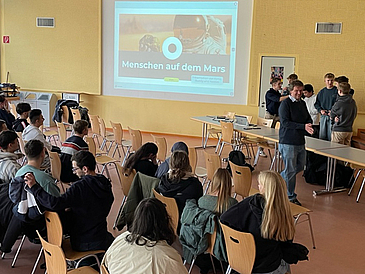Can humans live on Mars? What are microbially supported technologies? And how does computer-aided material modeling work? Pupils from year 12 of the Demenhorst Max-Planck-Gymnasium got to the bottom of these questions on November 2 and 3 in theory and practice. They took part in the University of Bremen's STEM camp and got to grips with mathematics, computer science, natural sciences and technology. In three groups, they got an impression of the university's lecture rooms and laboratories on campus, worked with scientific equipment and computer programs and presented their own results to their classmates the following week.
In an interview with the Weser Kurier, the four students Jan Hundelt, Nick Kraus, Nick Schröder and Tim Joritz were particularly enthusiastic about the modern setting of the university and impressed by the high level of motivation of the doctoral students. "It's important that students can try things out. This is how talents are discovered," explained Lucio Colombi Ciacchi. The professor at the Faculty of Production Engineering at the University of Bremen is the scientific coordinator of the MAPEX Core Facility and Director of the Master's degree course in Process-oriented Materials Research (ProMat). Even before the pandemic began, he established contact with several schools in the region. "As a research institute, we not only offer insights into research for students, but also for pupils - which can also generate enthusiasm," says Ciacchi. If the project is continued next year, he is also considering offering further training for teachers.
Group 1 of the students carried out measurements at the Center of Applied Space Technology and Microgravity (ZARM) over the two days. They were led by three scientists from the Humans on Mars initiative, Paul Große Maestrup, Dr. Christiane Heinicke and Dr. Cyprien Verseux. On the first day, the students were able to carry out work instructions in an astronaut simulation in exchange with the Mission Control Room. On the second day, they continued in the laboratory with measurements on bacterial nutrient media and microscopic examinations.
Group 2 visited the Center for Environmental Research and Sustainable Technologies (UFT). Together with Prof. Sven Kerzenmacher, Parisa Mahdavi and Prof. Jörg Thöming, they learned why bacteria there are fed with electricity and how wastewater is treated biologically. During visits to the Environmental Process Engineering and Chemical Process Engineering working groups, they were able to gain an impression of what a university biolab looks like and what is done in it.
Group 3 spent two days at the Bremen Computational Center for Material Sciences (BCCMS) focusing on computer-aided material modeling. They were able to try out X-ray microscopy and computer simulations with three scientists from the Hybrid Materials Interfaces working group, Pia Götz, Eric Macke and Prof. Lucio Colombi Ciacchi. These were used, for example, to examine a nail from the historic Bremen cog.


